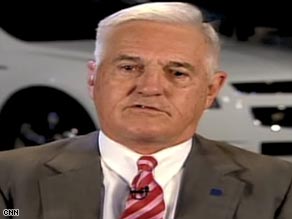Last-ditch efforts to forge an agreement to rescue the U.S. automakers fell apart late Thursday, Dec. 11, when union officials refused fast and deep cuts in worker pay. The collapse created the real possibility that General Motors (GM) and Chrysler will face bankruptcy in a matter of weeks, unless the Treasury Dept. acts to prevent it.
Senate Minority Leader Mitch McConnell (R-Ky.) said on the Senate floor Thursday night that a refusal of the United Auto Workers, headed by Ron Gettelfinger, to agree to lower wages and benefits at parity with workers at Toyota (TM) and Honda (HMC) in the U.S. by a date certain in 2009 was the last sticking point preventing Republicans from supporting the bill.
"We were three words away from a deal," said Senator Bob Corker (R-Tenn.), who spent all day trying to broker an agreement between Republicans, the union, and the auto companies. Tennessee is home to a GM and Nissan (NSANY) plant, as well as a future Volkswagen (VOWG.DE) plant and several supplier facilities.
Officials from the UAW did not return phone calls at press time.
"It's disappointing that Congress failed to act tonight," the White House said in a prepared statement. "We think the legislation we negotiated provided an opportunity to use funds already appropriated for automakers and presented the best chance to avoid a disorderly bankruptcy while ensuring taxpayer funds only go to firms whose stakeholders were prepared to make difficult decisions to become viable."
"A Loss for the Country"
The Senate rejected the bailout 52-35 on a procedural vote after the talks collapsed.
Senate Majority Leader Harry Reid (D-Nev.) called the bill's collapse "a loss for the country," adding: "I dread looking at Wall Street tomorrow. It's not going to be a pleasant sight."
The bill called for $14 billion to be divided between GM and Chrysler, both of which are at the financial breaking point as the recession and consumer credit crunch have crippled their finances. The companies, anticipating failure in the Senate, have hired bankruptcy law firms. Ford (F) has said it doesn't need federal assistance now but has asked for a $9 billion line of credit in case sales deteriorate below the current level.
According to Corker, bond holders that conferred with lawmakers Thursday agreed to take a 70% writedown on debt they hold from the automakers, and to take half of the remainder in stock. GM has $42 billion in debt, not counting payments the company must make to the union's health-care trust in 2010. As part of the deal, the UAW also agreed to take half of its future $21 billion in payments to its health-care fund in stock. "The companies would have been stronger than they have been in 40 years, or headed for Chapter 11," said Corker.
Senator Debbie Stabenow (D-Mich.) took a harsh and emotional tone with Republicans who voted against the bill. "Evidently the only thing that matters to those on the other side of the aisle is that workers make too much money," she said.
'Business' 카테고리의 다른 글
| The U.S. Economy's Best Bet: The Intangible Sector (0) | 2008.12.13 |
|---|---|
| Credit Crunch Unmasks Madoff (0) | 2008.12.13 |
| November video game sales near $3 billion (0) | 2008.12.13 |
| Steve Jobs' Greatest Surprises (0) | 2008.12.13 |
| Stocks Down As Auto Bailout Hopes Dim (0) | 2008.12.13 |







